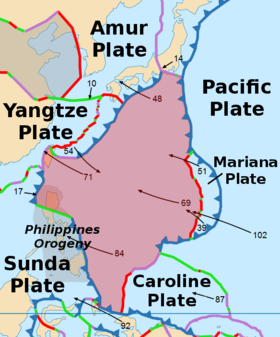| This article needs additional citations for verification. Please help improve this article by adding citations to reliable sources. Unsourced material may be challenged and removed. Find sources: "Philippine Sea plate" – news · newspapers · books · scholar · JSTOR (March 2017) (Learn how and when to remove this message) |
| Philippine Sea plate | |
|---|---|
 | |
| Type | Minor |
| Approximate area | 5,500,000 km |
| Movement | north-west |
| Speed | 48–84 mm/year |
| Features | Northern Luzon, Philippine Sea, Taiwan |
| Relative to the African plate | |
The Philippine Sea plate or the Philippine plate is a tectonic plate comprising oceanic lithosphere that lies beneath the Philippine Sea, to the east of the Philippines. Most segments of the Philippines, including northern Luzon, are part of the Philippine Mobile Belt, which is geologically and tectonically separate from the Philippine Sea plate.
The plate is bordered mostly by convergent boundaries: To the north, the Philippine Sea plate meets the Okhotsk microplate at the Nankai Trough. The Philippine Sea plate, the Amurian plate, and the Okhotsk plate meet near Mount Fuji in Japan. The thickened crust of the Izu–Bonin–Mariana arc colliding with Japan constitutes the Izu Collision Zone. The east of the plate includes the Izu–Ogasawara (Bonin) and the Mariana Islands, forming the Izu–Bonin–Mariana Arc system. There is also a divergent boundary between the Philippine Sea plate and the small Mariana plate which carries the Mariana Islands. To the east, the Pacific plate subducts beneath the Philippine Sea plate at the Izu–Ogasawara Trench. To the south, the Philippine Sea plate is bounded by the Caroline plate and Bird's Head plate. To the west, the Philippine Sea plate subducts under the Philippine Mobile Belt at the Philippine Trench and the East Luzon Trench. (The adjacent rendition of Prof. Peter Bird's map is inaccurate in this respect.) To the northwest, the Philippine Sea plate meets Taiwan and the Nansei islands on the Okinawa plate, and southern Japan on the Amurian plate. It also meets the Yangtze plate due northwest.

See also
References
- "Sizes of Tectonic or Lithospheric Plates". Archived from the original on February 9, 2007.
- Smoczyk, Gregory M.; Hayes, Gavin P.; Hamburger, Michael W.; Benz, Harley M.; Villaseñor, Antonio H.; Furlong, Kevin P. (2013). "Seismicity of the Earth 1900-2012 Philippine Sea plate and vicinity" (PDF). Open-File Report. Reston, VA. doi:10.3133/ofr20101083m.
{{cite book}}: CS1 maint: location missing publisher (link)
- Hall, Robert; Fuller, Michael; Ali, Jason R.; Anderson, Charles D. (1995), "The Philippine Sea Plate: Magnetism and reconstructions", Active Margins and Marginal Basins of the Western Pacific, Geophysical Monograph Series, vol. 88, pp. 371–404, doi:10.1029/GM088p0371, ISBN 0-87590-045-3
External links
- High-resolution map of Tectonic Plate Boundaries
- Map showing Seismicity of the Earth, 1900‒2012: Philippine Sea Plate and Vicinity United States Geological Survey
| Tectonic plates of Southeast Asia–New Guinea (Australian plate–Pacific plate convergence zone) | |||||||||||
|---|---|---|---|---|---|---|---|---|---|---|---|
| Large | |||||||||||
| Small |
| ||||||||||
| Faults | |||||||||||
| Trenches and troughs |
| ||||||||||
| Subsea plateaus and basins |
| ||||||||||
26°N 132°E / 26°N 132°E / 26; 132
This tectonics article is a stub. You can help Misplaced Pages by expanding it. |
